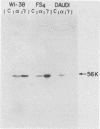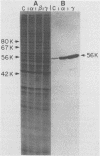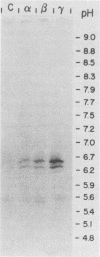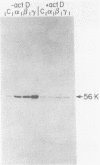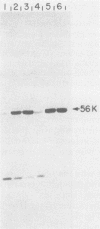Abstract
Interferon (IFN) treatment of cells induces the synthesis of several new proteins. A hybridoma cell line producing monoclonal antibody to the IFN-induced 56,000-dalton protein has been developed. The IFN-induced 56,000-dalton protein is synthesized by a variety of different cells and in response to IFN-alpha, IFN-beta, and IFN-gamma. The induction of this protein is dependent on de novo RNA synthesis, since its induction is inhibited if actinomycin D and the IFNs are added to the cells simultaneously. Labeling of IFN-treated cells at 4-h intervals at various times after the addition of the IFNs reveals that the synthesis of the 56,000-dalton protein in IFN-alpha-treated cells peaks within 12 h after the addition of the IFN and is no longer enhanced 20 h after exposure to the IFN. In contrast, IFN-gamma-treated cells continue to show an enhanced synthesis of this IFN-induced protein even after 20 h of exposure to the IFN. Thus, the synthesis of the IFN-induced 56,000-dalton protein is regulated differently by the different IFNs. When cells are treated with IFN-alpha or IFN-gamma in the presence of cycloheximide, and actinomycin D is added prior to the removal of the cycloheximide, the cells produce the IFN-induced 56,000-dalton protein and develop an antiviral state in response to both IFN-alpha and IFN-gamma. These results demonstrate that the synthesis of the 56,000-dalton protein is not dependent on the synthesis of an intermediary protein and that the establishment of an antiviral state occurs in the absence of multiple transcriptional events.
Full text
PDF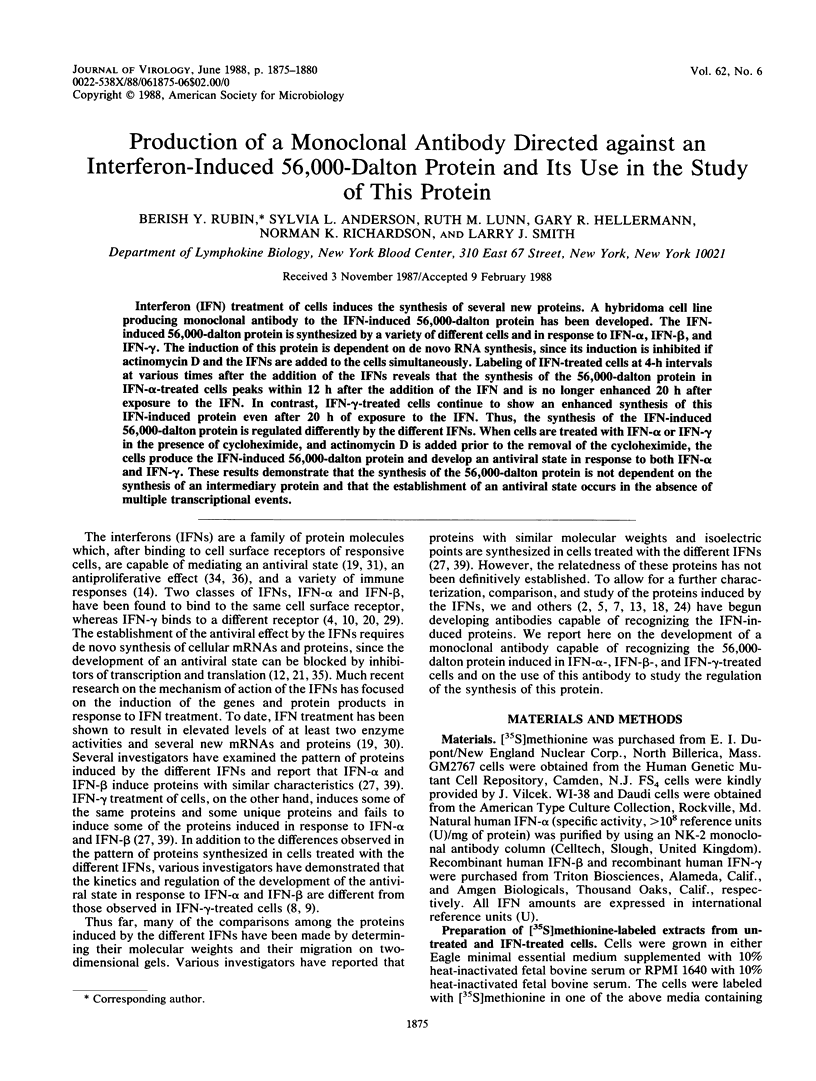
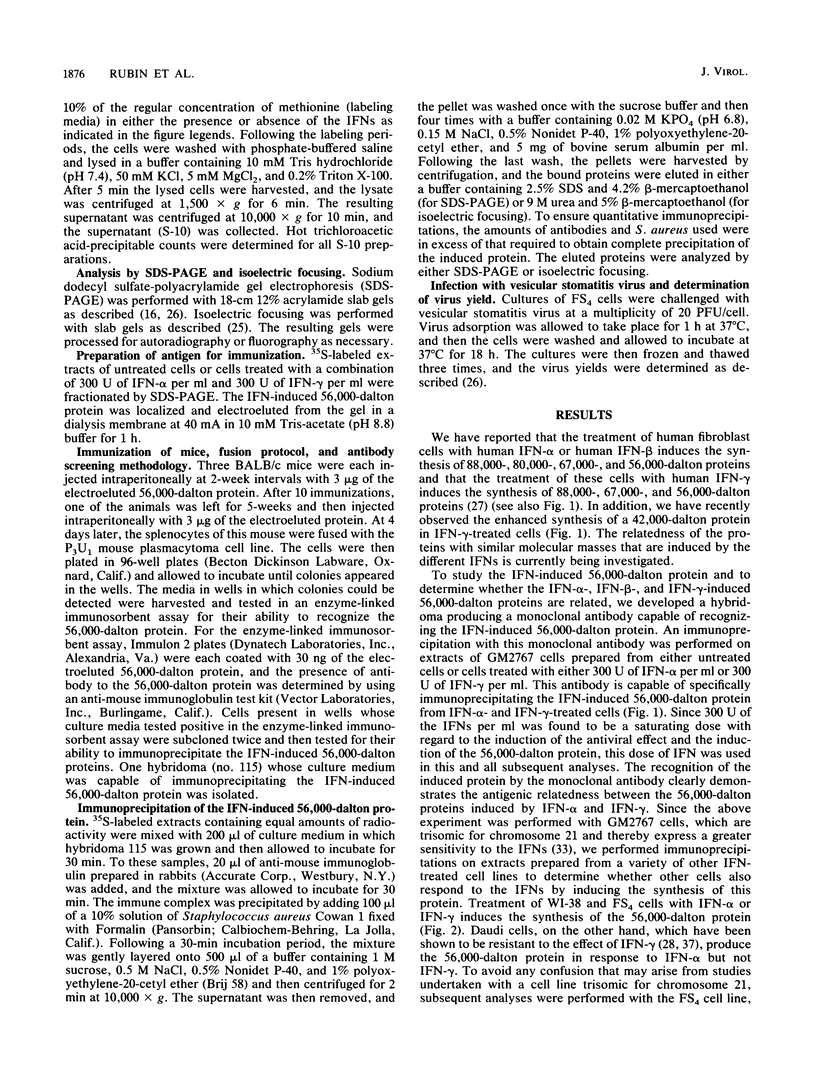
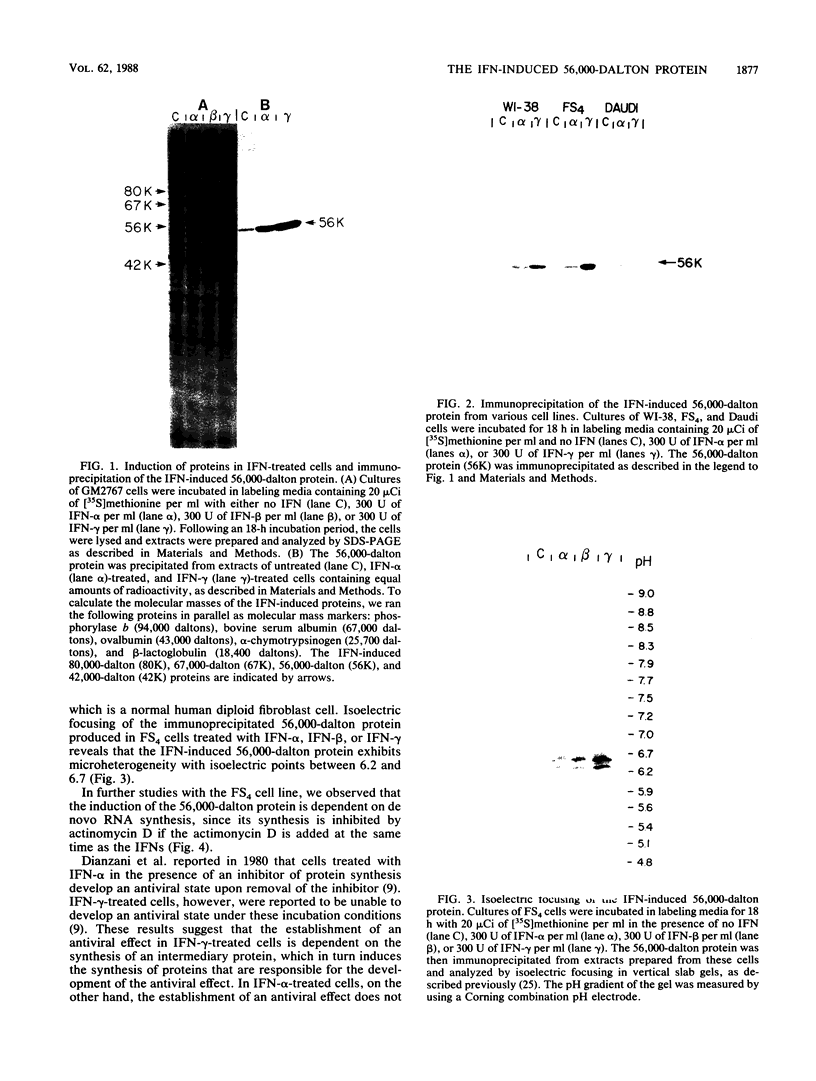
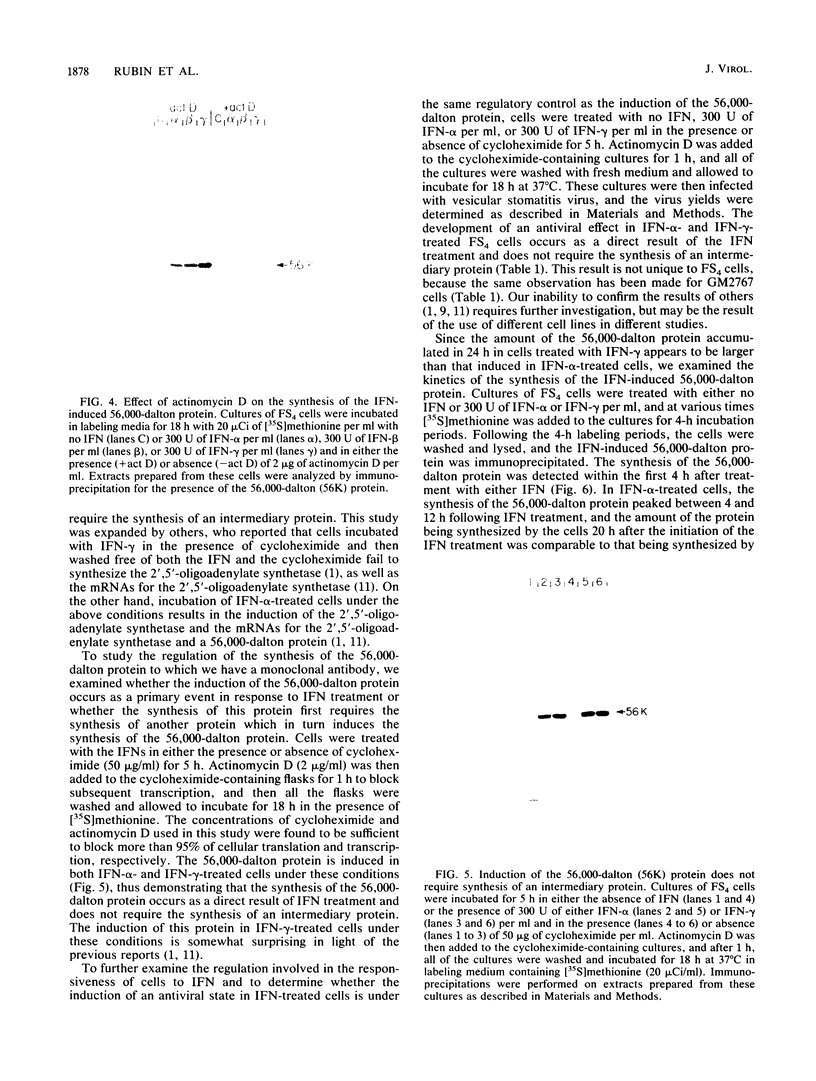
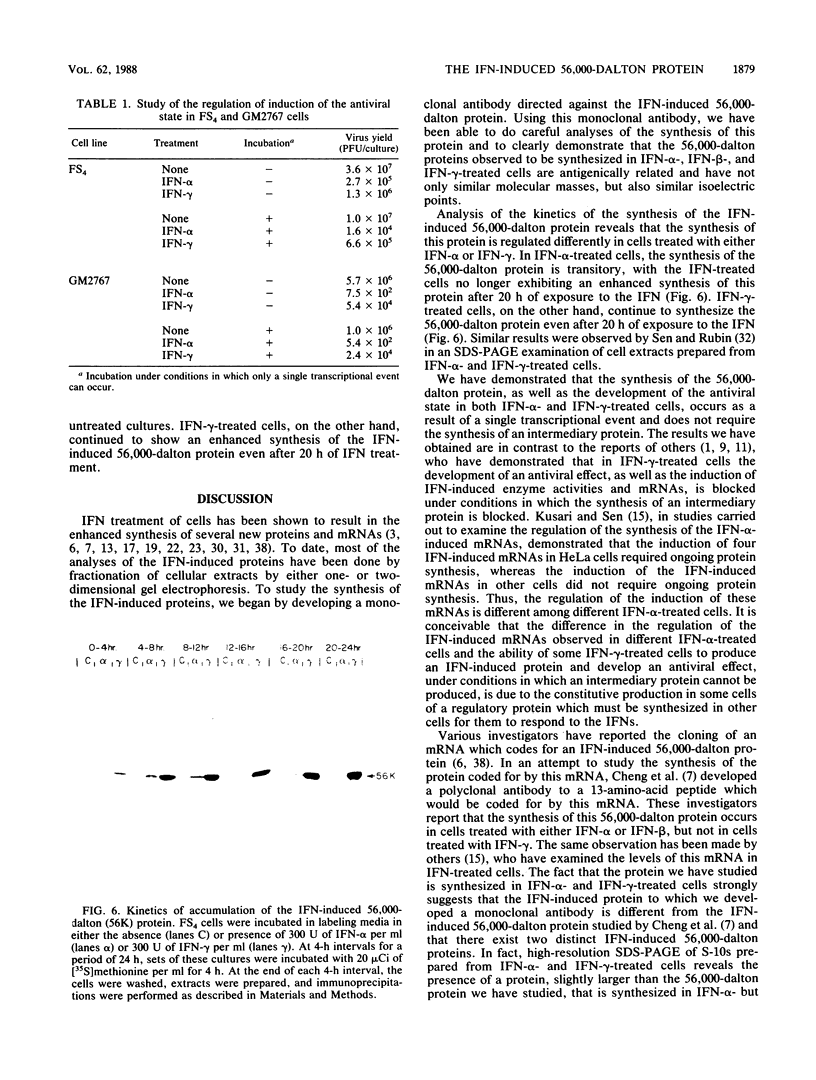
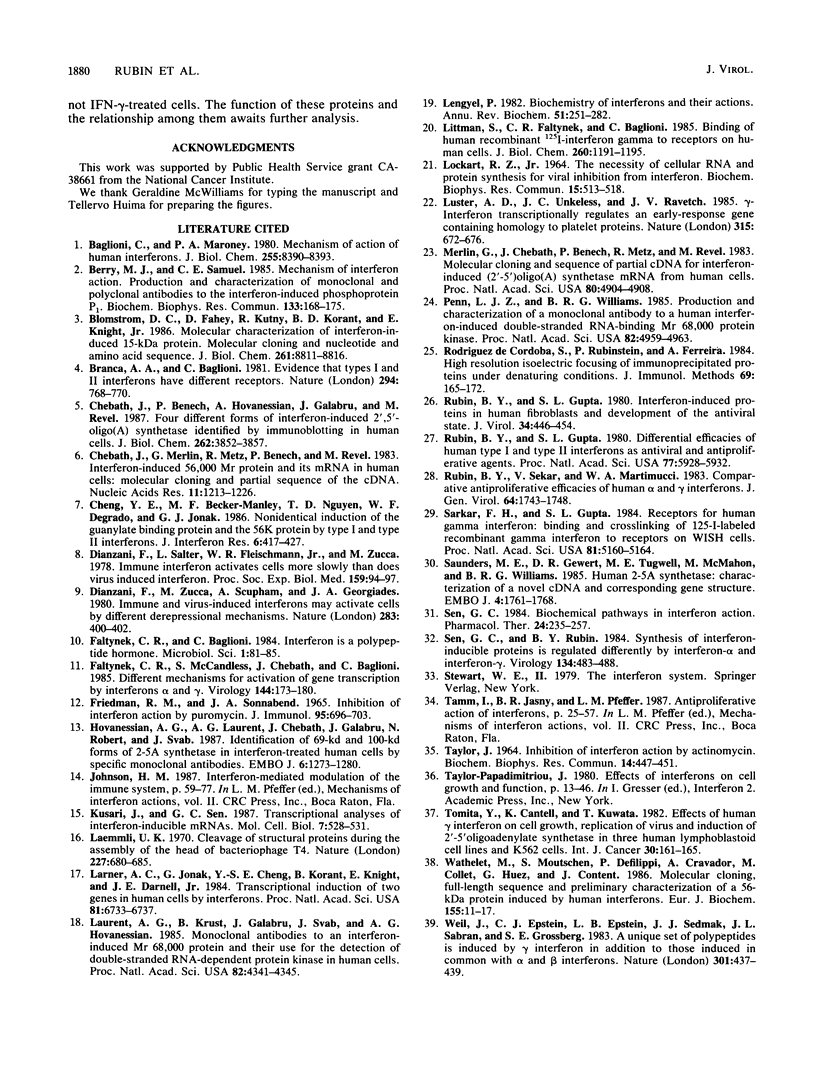
Images in this article
Selected References
These references are in PubMed. This may not be the complete list of references from this article.
- Baglioni C., Maroney P. A. Mechanisms of action of human interferons. Induction of 2'5'-oligo(A) polymerase. J Biol Chem. 1980 Sep 25;255(18):8390–8393. [PubMed] [Google Scholar]
- Berry M. J., Samuel C. E. Mechanism of interferon action. Production and characterization of monoclonal and polyclonal antibodies to the interferon-induced phosphoprotein P1. Biochem Biophys Res Commun. 1985 Nov 27;133(1):168–175. doi: 10.1016/0006-291x(85)91856-x. [DOI] [PubMed] [Google Scholar]
- Blomstrom D. C., Fahey D., Kutny R., Korant B. D., Knight E., Jr Molecular characterization of the interferon-induced 15-kDa protein. Molecular cloning and nucleotide and amino acid sequence. J Biol Chem. 1986 Jul 5;261(19):8811–8816. [PubMed] [Google Scholar]
- Branca A. A., Baglioni C. Evidence that types I and II interferons have different receptors. Nature. 1981 Dec 24;294(5843):768–770. doi: 10.1038/294768a0. [DOI] [PubMed] [Google Scholar]
- Chebath J., Benech P., Hovanessian A., Galabru J., Revel M. Four different forms of interferon-induced 2',5'-oligo(A) synthetase identified by immunoblotting in human cells. J Biol Chem. 1987 Mar 15;262(8):3852–3857. [PubMed] [Google Scholar]
- Chebath J., Merlin G., Metz R., Benech P., Revel M. Interferon-induced 56,000 Mr protein and its mRNA in human cells: molecular cloning and partial sequence of the cDNA. Nucleic Acids Res. 1983 Mar 11;11(5):1213–1226. doi: 10.1093/nar/11.5.1213. [DOI] [PMC free article] [PubMed] [Google Scholar]
- Cheng Y. S., Becker-Manley M. F., Nguyen T. D., DeGrado W. F., Jonak G. J. Nonidentical induction of the guanylate binding protein and the 56K protein by type I and type II interferons. J Interferon Res. 1986 Aug;6(4):417–427. doi: 10.1089/jir.1986.6.417. [DOI] [PubMed] [Google Scholar]
- Dianzani F., Salter L., Fleischmann W. R., Jr, Zucca M. Immune interferon activates cells more slowly than does virus-induced interferon. Proc Soc Exp Biol Med. 1978 Oct;159(1):94–97. doi: 10.3181/00379727-159-40291. [DOI] [PubMed] [Google Scholar]
- Dianzani F., Zucca M., Scupham A., Georgiades J. A. Immune and virus-induced interferons may activate cells by different derepressional mechanisms. Nature. 1980 Jan 24;283(5745):400–402. doi: 10.1038/283400a0. [DOI] [PubMed] [Google Scholar]
- Faltynek C. R., Baglioni C. Interferon is a polypeptide hormone. Microbiol Sci. 1984 Jul;1(4):81–85. [PubMed] [Google Scholar]
- Faltynek C. R., McCandless S., Chebath J., Baglioni C. Different mechanisms for activation of gene transcription by interferons alpha and gamma. Virology. 1985 Jul 15;144(1):173–180. doi: 10.1016/0042-6822(85)90315-0. [DOI] [PubMed] [Google Scholar]
- Friedman R. M., Sonnabend J. A. Inhibition of interferon action by puromycin. J Immunol. 1965 Oct;95(4):696–703. [PubMed] [Google Scholar]
- Hovanessian A. G., Laurent A. G., Chebath J., Galabru J., Robert N., Svab J. Identification of 69-kd and 100-kd forms of 2-5A synthetase in interferon-treated human cells by specific monoclonal antibodies. EMBO J. 1987 May;6(5):1273–1280. doi: 10.1002/j.1460-2075.1987.tb02364.x. [DOI] [PMC free article] [PubMed] [Google Scholar]
- Kusari J., Sen G. C. Transcriptional analyses of interferon-inducible mRNAs. Mol Cell Biol. 1987 Jan;7(1):528–531. doi: 10.1128/mcb.7.1.528. [DOI] [PMC free article] [PubMed] [Google Scholar]
- Laemmli U. K. Cleavage of structural proteins during the assembly of the head of bacteriophage T4. Nature. 1970 Aug 15;227(5259):680–685. doi: 10.1038/227680a0. [DOI] [PubMed] [Google Scholar]
- Larner A. C., Jonak G., Cheng Y. S., Korant B., Knight E., Darnell J. E., Jr Transcriptional induction of two genes in human cells by beta interferon. Proc Natl Acad Sci U S A. 1984 Nov;81(21):6733–6737. doi: 10.1073/pnas.81.21.6733. [DOI] [PMC free article] [PubMed] [Google Scholar]
- Laurent A. G., Krust B., Galabru J., Svab J., Hovanessian A. G. Monoclonal antibodies to an interferon-induced Mr 68,000 protein and their use for the detection of double-stranded RNA-dependent protein kinase in human cells. Proc Natl Acad Sci U S A. 1985 Jul;82(13):4341–4345. doi: 10.1073/pnas.82.13.4341. [DOI] [PMC free article] [PubMed] [Google Scholar]
- Lengyel P. Biochemistry of interferons and their actions. Annu Rev Biochem. 1982;51:251–282. doi: 10.1146/annurev.bi.51.070182.001343. [DOI] [PubMed] [Google Scholar]
- Littman S. J., Faltynek C. R., Baglioni C. Binding of human recombinant 125I-interferon gamma to receptors on human cells. J Biol Chem. 1985 Jan 25;260(2):1191–1195. [PubMed] [Google Scholar]
- Luster A. D., Unkeless J. C., Ravetch J. V. Gamma-interferon transcriptionally regulates an early-response gene containing homology to platelet proteins. Nature. 1985 Jun 20;315(6021):672–676. doi: 10.1038/315672a0. [DOI] [PubMed] [Google Scholar]
- Merlin G., Chebath J., Benech P., Metz R., Revel M. Molecular cloning and sequence of partial cDNA for interferon-induced (2'-5')oligo(A) synthetase mRNA from human cells. Proc Natl Acad Sci U S A. 1983 Aug;80(16):4904–4908. doi: 10.1073/pnas.80.16.4904. [DOI] [PMC free article] [PubMed] [Google Scholar]
- Penn L. J., Williams B. R. Production and characterization of a monoclonal antibody to a human interferon-induced double-stranded RNA-binding Mr 68,000 protein kinase. Proc Natl Acad Sci U S A. 1985 Aug;82(15):4959–4963. doi: 10.1073/pnas.82.15.4959. [DOI] [PMC free article] [PubMed] [Google Scholar]
- Rodriguez de Córdoba S., Rubinstein P., Ferreira A. High resolution isoelectric focusing of immunoprecipitated proteins under denaturing conditions. A simple analytical method applied to the study of complement component polymorphisms. J Immunol Methods. 1984 Apr 27;69(2):165–172. doi: 10.1016/0022-1759(84)90314-4. [DOI] [PubMed] [Google Scholar]
- Rubin B. Y., Gupta S. L. Differential efficacies of human type I and type II interferons as antiviral and antiproliferative agents. Proc Natl Acad Sci U S A. 1980 Oct;77(10):5928–5932. doi: 10.1073/pnas.77.10.5928. [DOI] [PMC free article] [PubMed] [Google Scholar]
- Rubin B. Y., Gupta S. L. Interferon-induced proteins in human fibroblasts and development of the antiviral state. J Virol. 1980 May;34(2):446–454. doi: 10.1128/jvi.34.2.446-454.1980. [DOI] [PMC free article] [PubMed] [Google Scholar]
- Rubin B. Y., Sekar V., Martimucci W. A. Comparative antiproliferative efficacies of human alpha and gamma interferons. J Gen Virol. 1983 Aug;64(Pt 8):1743–1748. doi: 10.1099/0022-1317-64-8-1743. [DOI] [PubMed] [Google Scholar]
- Sarkar F. H., Gupta S. L. Receptors for human gamma interferon: binding and crosslinking of 125I-labeled recombinant human gamma interferon to receptors on WISH cells. Proc Natl Acad Sci U S A. 1984 Aug;81(16):5160–5164. doi: 10.1073/pnas.81.16.5160. [DOI] [PMC free article] [PubMed] [Google Scholar]
- Saunders M. E., Gewert D. R., Tugwell M. E., McMahon M., Williams B. R. Human 2-5A synthetase: characterization of a novel cDNA and corresponding gene structure. EMBO J. 1985 Jul;4(7):1761–1768. doi: 10.1002/j.1460-2075.1985.tb03848.x. [DOI] [PMC free article] [PubMed] [Google Scholar]
- Sen G. C. Biochemical pathways in interferon-action. Pharmacol Ther. 1984;24(2):235–257. doi: 10.1016/0163-7258(84)90036-6. [DOI] [PubMed] [Google Scholar]
- Sen G. C., Rubin B. Y. Synthesis of interferon-inducible proteins is regulated differently by interferon-alpha and interferon-gamma. Virology. 1984 Apr 30;134(2):483–488. doi: 10.1016/0042-6822(84)90317-9. [DOI] [PubMed] [Google Scholar]
- Taylor J. Inhibition of interferon action by actinomycin. Biochem Biophys Res Commun. 1964;14:447–451. doi: 10.1016/0006-291x(64)90084-1. [DOI] [PubMed] [Google Scholar]
- Tomita Y., Cantell K., Kuwata T. Effects of human gamma interferon on cell growth, replication of virus and induction of 2'-5'oligoadenylate synthetase in three human lymphoblastoid cell lines and K562 cells. Int J Cancer. 1982 Aug 15;30(2):161–165. doi: 10.1002/ijc.2910300206. [DOI] [PubMed] [Google Scholar]
- Wathelet M., Moutschen S., Defilippi P., Cravador A., Collet M., Huez G., Content J. Molecular cloning, full-length sequence and preliminary characterization of a 56-kDa protein induced by human interferons. Eur J Biochem. 1986 Feb 17;155(1):11–17. doi: 10.1111/j.1432-1033.1986.tb09452.x. [DOI] [PubMed] [Google Scholar]
- Weil J., Epstein C. J., Epstein L. B., Sedmak J. J., Sabran J. L., Grossberg S. E. A unique set of polypeptides is induced by gamma interferon in addition to those induced in common with alpha and beta interferons. Nature. 1983 Feb 3;301(5899):437–439. doi: 10.1038/301437a0. [DOI] [PubMed] [Google Scholar]



